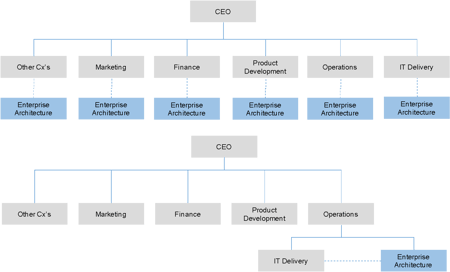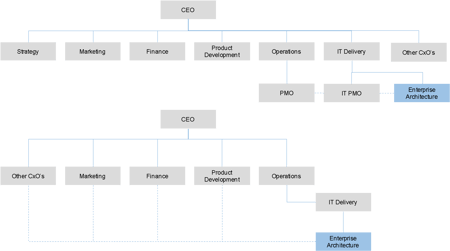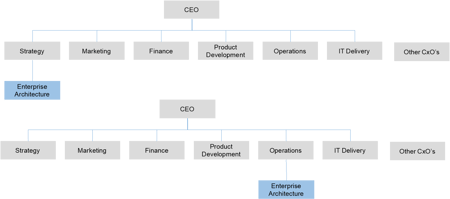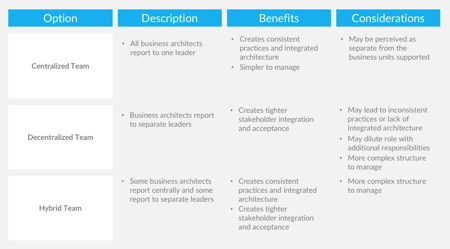[CONTINUED]
EA team structures based on project management
As pmi.org describes, when it comes to project management, there are three strategies architects can use to build and structure a team. These are:
- Collaborative EA,
- EA as a Service, and
- Large EA structure.
Each describes a potential starting point from which you can tailor your approach depending on the use case.
1. Collaborative EA
A collaborative EA team structure is used to support solution teams. Each team will have a designated architecture owner (AO) who is usually an agile solution architect.
This person is then responsible for guiding the team through decision-making processes and coaching other teams on architecture and design.
It’s vital that the AO has a good understanding of an organization’s enterprise architecture and needs. They also need to be able to collaborate closely with other architects in their team.
This team structure is typically used by architecture-led organizations and for large programs which require the work of a collaborative EA team.
Challenges: When using this model, it’s key for delivery teams and enterprise architecture teams to nominate their own AOs. They need to make sure that there is effective communication between the various architecture teams and stakeholders.
2. EA-as-a-Service
In an EA as a service team, stakeholders from external teams in the organization submit a request for the EA team to work on.
Work will typically involve reviewing processes and providing guidance on their architecture. This is a common type of team structure when EA teams are starting out or are new to an organization.
Challenges: Problems with this approach include underfunding and can devolve into a review-based or documentation-heavy approach to EA.
3. Large EA structure
A large EA team structure is used when an organization has hundreds or even thousands of individuals in solution delivery teams. For that reason, those need a much more sophisticated approach to organizing their EA activities.
This requires a multi-level approach based on regions or domains. In the example:
- 1st level: The first team works on a regional business unit, i.e. regional insurance in Europe,
- 2nd level: The second team works on the region as a whole, i.e. whole of Europe, and
- 3rd level: The third team works on the overall organization.
Challenges: Due to the size of the project and the teams involved, difficulties can arise in collaboration. However, this approach should reflect the overall structure of the organization.
How to build a new EA team?
When an organization is building its first EA team, there are several steps to consider to set itself up for success. Enterprise architects need an organized approach that reflects the changing business strategy.
There are six questions to consider when building your EA team, these are:
- What are your goals?
- Who are your stakeholders?
- How can you involve your stakeholders?
- What should your team size and structure look like?
- What solutions do we need?
- How can we gain buy-in from across the enterprise?
In the rest of the article, we will go into more detail on how to create a high-impact enterprise architecture team.
- Define the scope and objectives of the team
Before building your enterprise architecture team you need to consider what the team’s objectives and responsibilities are.
This means analyzing and identifying business processes, IT systems, and other infrastructure items that will help the team set goals and provide solutions.
📚 Related: Seven Use Cases solved with EA
- Determine the composition of the team
It’s vital that you choose roles with the right responsibilities to achieve the goals set in the early stages of the team-building process.
Once the scope and objectives have been defined, the next step is to create a team of IT architects, analysts, and other specialists.
This can include project managers, solution architects, business analysts, IT specialists, etc.
- Recruit team members
The next step is to recruit individuals with the right skills and experience for your team. This involves collaborating with HR or recruitment agencies and communicating the required qualifications and needs to find the right people.
They will then review resumes, conduct interviews and together with you select the right candidates for the team.
- Establish governance and operating model
Now that your team is coming together, the next step is to establish EA governance and define how the team will operate.
This includes how decisions are made, how reporting will work, and the relationship between your team and other areas of the organization.
This can involve creating procedures and policies for the team to follow and establishing lines of communication between major stakeholders.
- Provide training and development
Training and development is the key to the success of any EA team. As business needs to change and adapt over time, so does the underlying enterprise architecture.
It's essential all team members have access to workshops, courses, and mentoring programs that allows them to perform their jobs effectively in the future.
📚 Related: The Enterprise Architect of Tomorrow
- Align & lead the organization's strategy
Before starting EA activities, it’s key to align the enterprise architecture team's goals with the company’s overall business strategy. This is one of the main reasons for implementing enterprise architecture within an organization.
This means understanding business objectives and working with stakeholders to align technology with business processes to achieve company goals.
📚 2023 Gartner® Magic Quadrant™ for Enterprise Architecture Tools
What's next?
There is no right or wrong way to structure your enterprise architecture team. Each structure has its advantages and disadvantages based on the needs of the organization. Thus, it helps to be flexible when it comes to your team structure.
However, by considering the outlined structures and steps, you can build an enterprise architecture team that’s well-equipped to support the organization's objectives, create an EA strategy, select the EA tool for your needs, and establish an Architecture Review Board once complexity gets too much.




/What-to-Look-for-in-a-Modern-EA-Tool_Poster_Resource_Page_Thumbnail.png?width=400&height=283&name=What-to-Look-for-in-a-Modern-EA-Tool_Poster_Resource_Page_Thumbnail.png)



/EN-WP-EA-Tomorrow-Resource_Page_Thumbnail.png?width=260&height=171&name=EN-WP-EA-Tomorrow-Resource_Page_Thumbnail.png)
/EN-TopStakeholderQuestions-Poster_Resource_Page_Thumbnail.png?width=260&height=171&name=EN-TopStakeholderQuestions-Poster_Resource_Page_Thumbnail.png)
